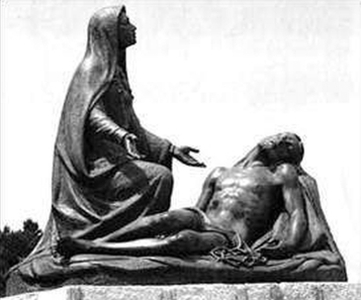c. 1600–1637; Patron Saint of the Philippines, Filipinos, immigrants, the poor, separated families, and altar servers; Canonized by Pope John Paul II on October 18, 1987
In 1549, Saint Francis Xavier and two Jesuit companions first reached Japanese soil with the Gospel. By the end of the century, Japan had an estimated 300,000 converts to the faith. By the 1580s, the Tokugawa shogun had become suspicious of Western Christianity, fearing that its spread could lead to European colonization. As a result, edicts were issued that outlawed Christianity. This led to thousands of martyrdoms between the years 1597 and 1639. Of those martyrs, twenty-six were canonized as saints in 1862, 205 were beatified in 1867, sixteen were canonized in 1987, two were beatified in 1989, and 188 were beatified in 2008. The saints commemorated today, Saints Lawrence Ruiz and Companions, are those sixteen who were canonized in 1987 by Pope John Paul II.
Lorenzo (Lawrence) Ruiz was born to a Chinese father and a Filipino mother in Binondo, Manila. The city of Binondo was established only six years before Lawrence’s birth by the Spanish governor for Chinese settlers who had converted to Catholicism. It soon became a vibrant and multicultural district, marked by many mixed marriages between Chinese and Filipinos, playing an important role in Manila’s commercial and cultural life. As a child, Lawrence learned Chinese from his father and Filipino from his mother, both of whom were Catholics. He was an altar boy at the local Dominican-run church, where he also received an education. Excelling in penmanship, he became employed as a scrivener, writing official documents, recording transactions, and keeping other written records. As he grew, he continued to be involved in parish life, joined the Confraternity of the Most Holy Rosary, and lived a normal life. In his late teens or early twenties, Lawrence married a woman named Rosario, and they had three children: two sons and a daughter.
During Lawrence’s lifetime, Spanish colonizers ruled the Philippines. Although they brought many benefits to the land, including numerous missionaries, the colonizers also often ruled with injustice. For instance, if a native Filipino killed a Spaniard, the crime would be met with swift retribution and severe punishment, disproportionately harsh towards the natives. Although an established legal system existed, it favored the Spaniards, so when a Filipino was accused of a crime, true and equal justice was not always guaranteed.
Unfortunately, Lawrence’s life took a tragic turn when, in 1636, around the age of thirty-six, he was falsely accused of a crime against a Spaniard, most likely murder, though records aren’t definitive. To escape unjust persecution, Lawrence hid from the authorities and boarded a ship with three Dominican priests, a Japanese priest, and a layman. Although the ship might have been initially destined for a peaceful Japanese port, it landed in Okinawa, Japan, where Catholic persecution was intense.
Shortly after the six arrived, the Tokugawa shogun became aware of their presence and had the group arrested. They were interrogated and informed they must leave Japan, to which they agreed. However, the shogun, unsatisfied with merely having them leave, also demanded they renounce their faith. This was a common tactic in Japan, aimed to eradicate the faith from the land. The belief was that if Christians publicly denounced their faith, other Japanese would see this as a sign of weakness and also abandon the faith. The group refused.
For over a year, this group of six remained imprisoned and were eventually transferred to Nagasaki. Throughout their captivity, they endured unimaginable cruelty. Water was poured down their throats, boards were placed on their abdomens, and they were subsequently jumped on, forcing the water out through their mouths, noses, and ears. They were cut and pricked with sharp bamboo, and endured severe psychological torture. One priest died on September 24, 1637. After that, two others considered renouncing their faith but found their resolve and held firm. Lawrence asked the torturers, “I would like to know if, by apostatizing, they will spare my life?” No answer came, and Lawrence remained resolute in his faith. They were then tightly bound to restrict blood flow and hung over pits. With one arm freed, they were told they merely needed to signal apostasy with that arm. They refused, remaining in that state for three days. Lawrence eventually proclaimed, “I am a Catholic and wholeheartedly accept death for God. Had I many thousands of lives, I would offer them all for Him. Never shall I apostatize. You may kill me if that is what you want. To die for God—such is my will.” Lawrence and his lay companion Lazaro died soon after, with the remaining three priests beheaded. They died on September 28 or 29, 1637.
The six martyrs included two laymen: Lawrence Ruiz and Lazaro of Kyoto; two Spanish Dominican priests, Fathers Antonio González and Miguel González de Aozaraza de Leibar; French priest Father Guillaume Courtet; and Japanese Dominican Father Vincentius Shiotsuka. Also honored today are five priests, two religious brothers, and three laypeople who were martyred in 1633 and 1644. The priests were Fathers Dominic Ibáñez de Erquicia Pérez de Lete, Jordan Ansalone, Luke of the Holy Spirit Alonso Gorda, Jacobo Kyushei Gorōbyōe Tomonaga de Santa María, and Thomas Rokuzayemon. The religious brothers were Francis Shōyemon and Matthew Kohioye. The laypeople were Marina of Omura, Magdalene of Nagasaki, and Michael Kurobioye.
As we honor these heroic witnesses to the Catholic faith, ponder the fact that their lives concluded with exceptional pain and suffering. Still, their eternal lives in Heaven are now celebrated with the highest praises. Saint Lawrence Ruiz, memorialized in today’s commemoration, was the first Filipino martyr, making his witness greatly revered among Filipino Catholics who seek his intercession. Saint Lawrence, along with the numerous other Japanese martyrs from the late sixteenth and seventeenth centuries, did more for the faith by courageously sacrificing their lives than they could have by living comfortably. Love is sacrificial, and while we might not be called to be martyrs in blood, we must nurture a faith so profound that it bears the same witness, sacrificially dedicating our lives for Christ and the salvation of souls in whatever ways we are called.
Source: https://mycatholic.life/saints/saints-of-the-liturgical-year/september-28—saint-lawrence-ruiz-and-companions-martyrs/







